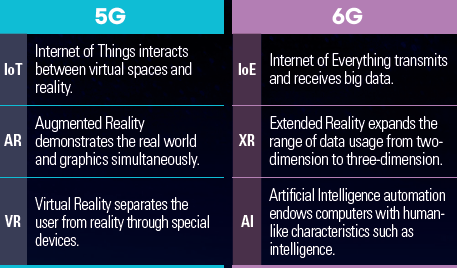In January, Lee Jae-yong, the chairman of Samsung Electronics, announced a strategy to preempt the 6G telecommunications market as the company’s first major product of the new year. Although the public expectation for the commercialization of advanced intelligence is growing rapidly, concerns about the existing 5G technology still remain. The Sungkyun Times (SKT) examines Korea’s 6G market, discusses its economic pros and cons, and explores the prospects of the 6G industry.
Taking Action on 6G
- The Sixth Hot Potato
Commonly known as 6G, sixth-generation mobile communication provides higher energy efficiency and a wider range of networks. In 2011, long-term evolution (LTE) incorporated 4G into mobile phones, enabling video streaming. In 2020, 5G innovated personal communication to an industrial infrastructure in factories. In essence, utilized technologies can change as new generation infrastructure evolves. With the vision of expanding this convergence across societal domains, 6G aims to achieve ultra-wideband, ultraconnectivity, and ultra-low latency with global research and development (R&D) efforts underway. By incorporating artificial intelligence (AI) into satellites, transmission speed is expected to be 50 times faster, with the number of devices that can connect to a single base station increasing by dozens of times compared to 5G. An essential piece of technology that enables this is TeraHertz Frequency (THF). Here, Hertz (Hz) refers to the international frequency unit representing the number of vibrations per second. The THF band involves frequencies between 100GHz and 10THz as candidates for future 6G communication, which aims to be 50 times faster than 5G. The Electronics and Telecommunications Research Institute (ETRI) forecasts that THF, capable of exponentially magnifying speeds, will be instrumental in the 6G industry.

- Global R&D Trends
Since 6G can be integrated with various industries, there is fierce competition among many companies and nations. In the United States (U.S.), the Alliance for Telecommunications Industry Solutions, established to forestall the 6G market, has founded the Next G Alliance, which has published a roadmap called White Paper to encourage enterprise collaboration. Europe, centering on the research financial support program named Horizon Europe, aims to lead the international challenge of energy saving through 6G innovation. Japanese wireless telecom company NTT DOCOMO is also pushing for a 6G attraction through national projects. Fueled by this global trend, Korea also selected 6G as one of its 12 major national strategies and has been vigorously fostering the development since last year. Samsung Electronics announced its foray into 6G R&D with the publication of the 6G White Paper in 2020, while LG succeeded in transmitting and receiving 6G over the world’s longest urban distance of 500m in December 2023. In support of these corporate challenges, the Korean government has invested ₩440.7 billion in 6G, striving to secure global leadership.

The Sixth Generation, Innovation and Challenge
- Strengths of the Korean 6G Market
1) Integration with Existing Industries
6G technology can be integrated with various sectors of daily life, making it highly practical. Its applications range from manufacturing to healthcare and entertainment, securing it as an essential technology that expands into the prospects of other industries. For example, within the manufacturing sector, 6G technology can enable automation that oversees the entire process, from autonomous vehicles to automotive sensors, by utilizing Internet of Things (IoT) connectivity. Another example is enhancing remote communication through smart glasses, an advanced form of non-face-to-face meetings. These cases of technological integration into everyday life are possible because the 6G’s internalization of AI largely broadens its frequency rate. Notably, an AI physics model enables an implementation on personal laptops, which is a substantial advancement considering that these tasks were once exclusively compatible with supercomputers. Moreover, the components required for 6G also enable the conversion of various technologies. They have significantly higher efficiency since they have evolved to control only the essential base stations without separate batteries or power. In an interview with the SKT, one Samsung Electronics engineer mentioned, “Technological mission focuses on increasing connectivity between existing and new industries.” This is why many companies and countries are preparing for the advent of 6G, anticipating its promising industrial advantages.

2) Pioneering New Industrial Frontiers
6G is known for its unparalleled agility with virtually no delays, thus creating novel services. Ultra-high speed and ultra-low latency are facilitated by AI optimization, which enables these renovations. These essential characteristics for complete automation indicate the potential for new industries, as 6G can receive and transmit information immediately without intervention. Particularly in the space industry, the development of a modern-day Iron Man becomes ever more feasible, encompassing everything from the design, construction, and operation of ground stations to the processing, analysis, and utilization of satellite data. Scenes depicting Tony Stark receiving answers from a hologram from within his laboratory provide a glimpse into the greatness of 6G. Countries that preemptively adopt 6G are expanding the realm of AI into new environments. Another emerging industry is Urban Air Mobility (UAM), a form of airborne transportation that uses urban airspace to travel the shortest distance. To ensure safety and speed, 6G, with its minimal delay, is essential for flights using UAM. Major Korean telecom companies are also developing UAM satellite communications, sparing no effort in establishing future urban transportation systems.
- Nevertheless Insufficient
1) The Generational Dilemma
Despite the worldwide interest in 6G, the imperfections of the existing 5G technology are evident. Accumulated consumer dissatisfaction due to expensive service fees and the slow speed of 5G have led to an overall distrust in telecom companies. According to an interview with Money Today News on June 26th of 2023, a telecommunication official mentioned, “5G users are leaning towards LTE phones in favor of the relatively low cost.” Consequently, the government has been continuously demanding 5G telecom companies to lower their fees. It is undeniable the three big telecom companies, KT, LG U+, and SK Telecom, failed to meet the target revenue of 5G sales set at the beginning of 2023. By the end of the year, they failed to utilize and returned all the 5G frequencies at 28 GHz that had been allocated by the government, expressing regret that the rudiments did not meet commercialization standards. Given that the initially planned 15,000 base stations became redundant, moving to the next industry without addressing the causes of failure has clearly been a white elephant. This also resulted in a decrease in the future Information and Communications Technology (ICT) fund revenues from the National Assembly Budget Office. As a result, the development of ultra-high frequency has been delayed, which is hindering the 6G industry.

2) THF, a Growing Concern
A lack of foundation for THF, the key to 6G, is a major obstruction in commercialization. Due to the high-frequency range of THF, this inherent wave trait causes significant path loss over short distances. This defect requires advanced beamforming technology, which shapes frequencies into a beam, allowing the concentration of communication power in one direction by gathering dissipating waves. However, in Korea, a network that connects multiple antennas on an ultra-fast basis is not available yet. On December 20th, 2023, Ulsan National Institute of Science & Technology (UNIST) developed a technology that can amplify THF electromagnetic waves, which improves the existing THF resonators by 300%. However, as waves travel, their distance is inversely proportional to the frequency. As a result, the significantly increased frequency of THF raises susceptibility to interference from overlapping waves. This interference can block the waves from passing obstacles, setting off alarm bells against the tall buildings of Korea.

The Jury Is Still Out
- Improving 5G and Developing 6G
To become a forerunner in the 6G business, Korea must analyze the causes of failure in the 5G market and concurrently advance 6G R&D in line with consumer demands. In an interview with Chosun I lbo on J anua r y 4 th, Professor Kim Beom-jun from the Department of Accounting at Catholic University of Korea pointed out that continuous network investment is necessary for the three major telecom companies to fulfill their social responsibilities as license holders. Hwang Jungin (Junior, Department of Global Business Administration) mentioned in an interview with the SKT, “I am looking for a new smartphone which does not rip off the cost like the 5G companies.” Since the telecom monopoly has cornered the market and led to consumer dissatisfaction, government intervention becomes crucial to supply affordable telecommunications. Improving the brand image of extant 5G companies such as LG U+ is vital in entering the 6G market. Resolving 5G customer complaints about fees can stimulate consumption, potentially recovering frequency allocation as well as budget distribution and ultimately fostering investment in 6G. In July 2023, the Minister of Science and ICT, Lee Jong-ho, announced the Telecommunications Competition Plan to support the policy of lowering fees. However, structural improvements are still necessary as household burdens remain. Improving this market structure involves dismantling the rigidity of monopolistic corporations and facilitating the entry of new operators. For instance, Japan’s Local 5G improved public awareness of 5G through national incentive policies. It achieved this by focusing on startup companies, halving the implementation costs, and breaking down the entry barriers of high initial expenses.

- The Key to Unlocking THF
The Key to Unlocking THF Collaborative governance of THF is essential in improving the flaws of the market. Lee Jae-yong highlighted the proactive investment in an interview with JoongAng Ilbo on January 10th, stating, “The future depends on 6G acquisition. Unwavering R&D and investment are necessary.” The government needs to attract core industries for domestic companies, and companies should focus on improving the productivity and safety of THF. Expanding base transceiver stations indefinitely without a stable basis will confuse the network. Thus, initial state intervention is pivotal. For instance, the wireless Backhaul can be applied to mobile communications, enhancing transmission speed and moving beyond the design phase. Referring to the THF implementation of the U.S. can be practical for resolving interference issues. In 2017, the Defense Advanced Research Project Agency started a 6G project and operated the Joint University Microelectronics Program (JUMP) with a $200 million investment. The development of multi-user frequency, expandable beyond 140GHz, was achieved by adding adaptable antennas to resolve the interference issues. Similarly, although Korea is still in its infancy for 6G, it can capture both efficiency and safety in ultra-wide, ultra-precise, and high-performing THF.
6G, known as the “dream communication,” will surpass 5G in speed, usability, accuracy, and safety. Korea must earnestly launch the competitiveness of 6G, overcoming commercial and technological limitations. The SKT is confident that 6G will open an era of superintelligence by connecting the world in new ways.
